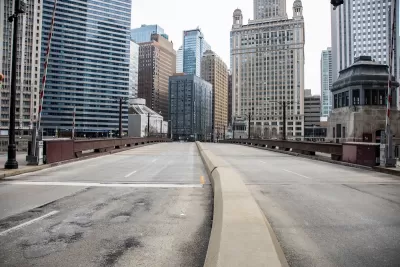Research shows that the “donut effect” hollowing out central business districts since the pandemic continues to cause economic decline in the 12 largest American cities.

New research from Stanford University economist Nicholas Bloom indicates that the structure of some of the largest U.S. cities remains fundamentally changed since the Covid-19 pandemic. Bloom has dubbed this the “donut effect,” referring to “the hollowing out of big-city financial districts, the rising attraction of surrounding areas, and the impacts on local economies.”
Bloom and his team conclude that downtown economies are not, in fact, bouncing back after the pandemic. According to Bloom, the 12 largest U.S. cities have lost 8 percent of their downtown residents, with two-thirds of those households migrating to suburbs. There was also an attendant drop in the number in businesses in downtowns in major metro areas. “The reason, according to the study’s authors, is because of the staying power of working from home – particularly for high-skilled workers who made up the bulk of downtown exits during the pandemic.”
This means a sharp drop in tax revenue and economic activity for cities, where officials must make difficult decisions to accommodate lower budgets. For public transit agencies, changes in travel patterns have led to sometimes devastating cuts in budgets and service.
Bloom points to one potential benefit of the effect, provided that housing costs go down. “As essential workers and others with lower-paying, in-person jobs get priced out of the suburbs, they might be able to afford living again in the big cities where they need to be every day.”
The donut effect is notably absent or limited in small and medium-sized cities, where more jobs require in-person attendance and housing costs are lower.
FULL STORY: For major U.S. cities, the ‘donut effect’ persists

Planetizen Federal Action Tracker
A weekly monitor of how Trump’s orders and actions are impacting planners and planning in America.

Maui's Vacation Rental Debate Turns Ugly
Verbal attacks, misinformation campaigns and fistfights plague a high-stakes debate to convert thousands of vacation rentals into long-term housing.

San Francisco Suspends Traffic Calming Amidst Record Deaths
Citing “a challenging fiscal landscape,” the city will cease the program on the heels of 42 traffic deaths, including 24 pedestrians.

Amtrak Rolls Out New Orleans to Alabama “Mardi Gras” Train
The new service will operate morning and evening departures between Mobile and New Orleans.

The Subversive Car-Free Guide to Trump's Great American Road Trip
Car-free ways to access Chicagoland’s best tourist attractions.

San Antonio and Austin are Fusing Into one Massive Megaregion
The region spanning the two central Texas cities is growing fast, posing challenges for local infrastructure and water supplies.
Urban Design for Planners 1: Software Tools
This six-course series explores essential urban design concepts using open source software and equips planners with the tools they need to participate fully in the urban design process.
Planning for Universal Design
Learn the tools for implementing Universal Design in planning regulations.
Heyer Gruel & Associates PA
JM Goldson LLC
Custer County Colorado
City of Camden Redevelopment Agency
City of Astoria
Transportation Research & Education Center (TREC) at Portland State University
Jefferson Parish Government
Camden Redevelopment Agency
City of Claremont





























